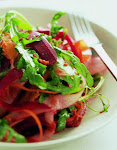There were two major kinds of diet in the peninsula. One was found in the northwest part of the peninsula, with more animal fats that correspond to the agriculture of the North. The other one was found in the southerly parts of the peninsula and could be considered the ancestor of Mediterranean diet.
ANDALUSIAN CUISINE
Fried foods
 ← Puntillitas, battered and fried baby squid
← Puntillitas, battered and fried baby squid
Frying in Andalusian cuisine is dominated by the use of olive oil that is produced in the provinces of Jaén, Córdoba, Seville, and Granada.
The foods are dredged in flour a la andaluza (meaning only flour, without egg or other ingredients, but may include flour from the chickpea especially for use in batters). They are then fried in a large quantity of hot olive oil.
Fish and shellfish
With five coastal provinces, the consumption of fish and shellfish is rather high: white shrimp from the Bay of Cádiz; prawns; murex; anchovies; baby squid; cuttlefish; "bocas de la Isla", a dish found in San Fernando that uses a local crab that can regenerate its claw; flounder; smelts; etc.
Desserts
← Pestiños de Miel, a honey-coated sweet fritter
Andalusian desserts are heavily influenced by medieval Andalusian cuisine. Notable dishes include pestiños (a deep-fried pastry bathed in honey), alfajores, amarguillos (a form of almond macaroons) from Medina Sidonia, the polvorones (almond cookies of Estepa), lard bread, wine doughnuts, and torrijas.
Typical Andalusian dishes include “pescaito frito” (fried fish), gazpacho, Cordoban salmorejo, pringá, oxtail, jamón ibérico (Iberian ham), prepared olives, alboronía, poleá; anise; Málaga wine; various kinds of wine, including sherries, (fino, manzanilla, oloroso, Pedro Ximénez, amontillado, which are undoubtedly the most exported and most widely available of all Spanish wines.
TAPAS
Going for tapas is a typical social ritual of the province. They are a rem
arkable aspect of the local cuisine. The tapas are served free by all bars in the province and along with the glass of wine or beer are a tasty symbol of Granada.
King Alfonso X ordered that in the inns of his kingdom that wine would not
be served if it wasn't accompanied by some food to prevent people getting drunk quickly.
The cap, initially, was deposited on the mouth of the jar or glass used, s
o that "hid" the container: hence the origin of the word. It served to accompany drinks and to prevent any insect from entering the precious liquid. In those days the top was a slice of ham or sliced chorizo or other sausage and, at times, was replaced by a wedge of cheese; currently you can find a lot of diferents kinds of foods when you go for tapas.
SOME OTHERS DISHES
Preparation: The tomatoes are cut, the peppers, the cucumber (is good to leave a little each one of these ingredients to add them later as stumbles if we want to eat it like soup) and the garlic clove peeled and they are thrown in a large bowl. Then oil, vinegar and salt are added to the flavor. All this beat well with a mixer. If the mass turns out to be very thick, water is added until obtaining the consistency desired. It is presented in a large bowl. It is served in cups or in glasses if you want to drink it and not eat it as soup.
Spanish omelette:
The Spanish omelette or omelette of potatoes, is a dish based on eggs and potatos.
The name comes from its form of cake or omelette.  It is one of the most typical dishes of the Spanish kitchen that can be found in almost any bar or restaurant.
It is one of the most typical dishes of the Spanish kitchen that can be found in almost any bar or restaurant.




